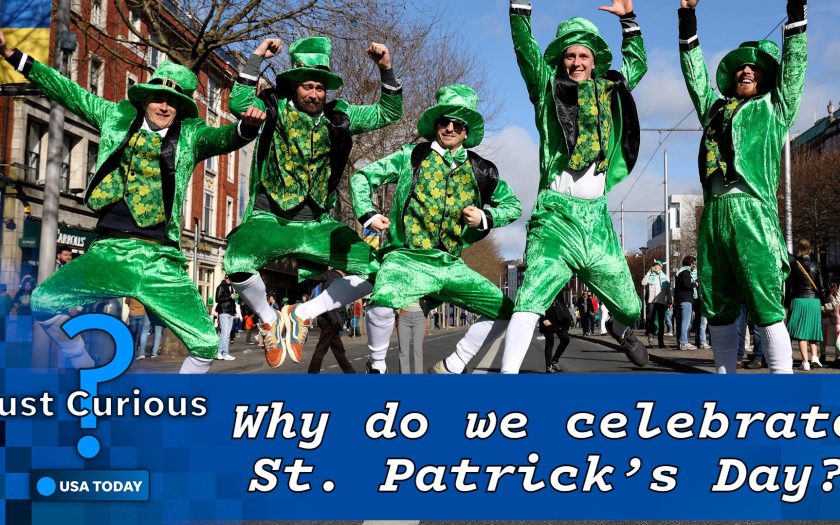What is St. Patrick’s Day? Why do we celebrate it? The Irish holiday explained
Kinsey Crowley
,
Marina Pitofsky
,
Erin Jensen
USA TODAY
Show CaptionHide Caption#videoDetailsToggle{color:var( –color-dove-gray,rgba(0,0,0,.6));cursor:pointer;display:inline-block;font-family:var(–sans-serif,sans-serif);font-size:var(–type-7);font-weight:var( –font-weight-bold,900);line-height:var(–spacer-twentyfour,24px);margin-bottom:-8px}#vdt_hide{margin-bottom:10px}.vdt-flex[hidden]{display:none}.vdt-svg{fill:var( –color-dove-gray,rgba(0,0,0,.6));height:var(–spacer-twentyfour,24px);width:var(–spacer-twentyfour,24px)}When is St. Patrick’s Day? Here’s why we celebrate the holidayWho was Saint Patrick and why do we celebrate him? Here’s what to know about St. Patrick’s Day.
Cities dye their rivers green. The head politician of Ireland visits the U.S. to meet with the president. Patrons clink mugs full of green beer.
This Sunday, March 17, is St. Patrick’s Day While it may be an informal drinking holiday for many Americans, it is actually a national holiday in Ireland and a source of great pride.
To get the scoop on the holiday’s backstory, USA TODAY previously spoke with Elizabeth Stack, executive director of Albany’s Irish American Heritage Museum, and Brian Witt, the cultural exhibits coordinator for Milwaukee Irish Fest.
Here is what to know about St. Patrick’s Day:
2024 calendar dates: Easter, Memorial Day, Thanksgiving and other key holiday dates to remember
What is the meaning behind St. Patrick’s Day?
St. Patrick is the patron saint of Ireland, brought to the Emerald Isle when he was kidnapped and enslaved. Though he eventually escaped, he returned and advanced Christianity throughout the island.
Witt says the day gives Irish and Irish Americans the opportunity to “celebrate their heritage,” and Stack agrees that the parades in places like the states and England convey “that the Irish people have made a contribution to the society – that they were sort of welcomed, that they were accepted as citizens.”
Once a solemn religious holiday, Stack said it didn’t take on the drinking stereotype until America started celebrating the day.
It is still a bank holiday and a big family day in Ireland, even though St. Patrick himself was supposedly born in Britain.
St. Patrick’s Day 2024: Luck of Irish not needed to save some green on St. Patrick’s Day food and drink deals
Why is St. Patrick’s Day celebrated on March 17?
March 17 is the day St. Patrick is believed to have died.
Irish people in America by the numbers
According to a press release from the U.S. Census Bureau, many Americans have something to celebrate this St. Patrick’s Day:
- 30.7 million U.S. residents claimed Irish ancestry in 2022.
- Cook County, Illinois, which includes Chicago, is the nation’s county with the largest Irish-American population, according to 2022 data. The population comes in at 418,997.
- 112,251 U.S. residents were born in Ireland.
Fun fact: The original color associated with St. Patrick isn’t green
St. Patrick is actually tied to the color blue. So why do people cloak themselves in green?
“The Irish Americans would wear the green as a reminder that they were nationalists first and foremost,” explains Witt. “The colors of the Irish flag are green, white and orange, the green symbolizing the Irish nationalism, the orange symbolizing the Orangemen of the north and the white symbolizing peace.”
Stack mentions the mythical belief that green is to be worn to “make you invisible to leprechauns,” which she says originated in America.
Is St. Patrick’s Day a federal holiday?
St. Patrick’s Day is not a federal holiday in the United States. Post offices, banks, and most businesses and stores will be open on Friday, even amid parades and other celebrations.
html a.nsb-link,html .primary-content a.nsb-link{box-shadow:0 0;cursor:pointer;height:var(–spacer-twentyfour,24px);margin-right:var(–spacer-twentyfour,24px);text-shadow:none;width:var(–spacer-twentyfour,24px)}a.nsb-link span{max-width:0;overflow:hidden;position:absolute;visibility:hidden}.nsb-svg{height:var(–spacer-twentyfour,24px);width:var(–spacer-twentyfour,24px)}.nsb-twitter-button{fill:var(–social-twitter,#4099ff)}.nsb-email-button{fill:var(–color-dove-gray,#787878)}.nsb-facebook-button{fill:var(–social-facebook,#3b5998)}.nsb-sms-button{fill:var(–color-ui-green,#008c33)}.nsb-svg.gallery{fill:var(–color-ui-white,#fff)}FacebookTwitterEmail

